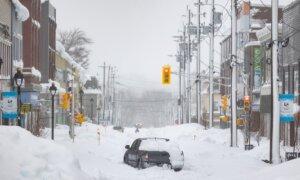Messy conditions persisted in Nova Scotia and Newfoundland and Labrador on Feb. 15, the second day of a winter storm that unleashed more snow and high winds in the region.
Schools were closed for a second consecutive day in the St. John’s, N.L., metro area, as some parts of the city dug out from under 40 centimetres of heavy, wet snow.
“It definitely takes a while to clean up, especially in the places that got the higher amounts,” said Tiffany Cheeks, a meteorologist with Environment Canada.
High winds were blowing snow around in some parts of eastern Newfoundland, making it difficult to see when driving, she said, adding that gusts were clocked in the Bonavista area on Feb. 14 at 115 kilometres an hour.
In central Newfoundland, the Gander area was hit particularly hard on Feb. 14, with 49 cm of snow recorded at the town’s airport.
Winter storm warnings remained in place for the island’s Bonavista and northern Avalon peninsulas, and the Gander region on Feb. 15. Environment Canada asked residents around Gander to brace for up to 75 cm of snow by early on Feb. 16. Bonavista and St. John’s would likely see between 40 cm and 60 cm.
Residents should postpone travel if they could, and stay off the roads, the weather agency said.
About 50 cm of snow was expected by Feb. 17 or early on Feb. 18 along Labrador’s north coast, from Postville to Makkovik. Ms. Cheeks said up to 100 cm could fall in the region’s inland areas.
Meanwhile in Nova Scotia, the same low-pressure system that has brought so much foul weather to Newfoundland and Labrador is still unloading on parts of Nova Scotia.
Schools were closed across Cape Breton and much of the province’s eastern mainland as northwesterly winds gusting at 70 k/h reduced visibility in Pictou and Antigonish counties, where another 10 cm of snow was in the forecast.
“Travel is expected to be hazardous due to reduced visibility in some locations,” Environment Canada said in a statement. “Visibility may be significantly and suddenly reduced to near zero.”
In Cape Breton, a winter storm warning remained in effect for Inverness County on the west side of the island, where another 10 to 20 cm of blowing snow was expected on Feb. 15. “There may be a significant impact on rush hour traffic in urban areas,” Environment Canada said.







